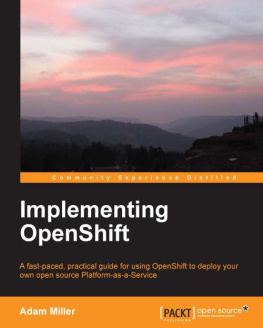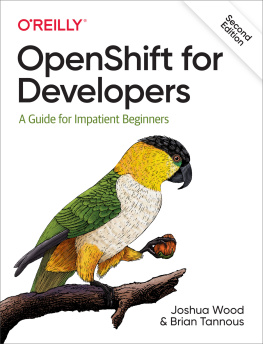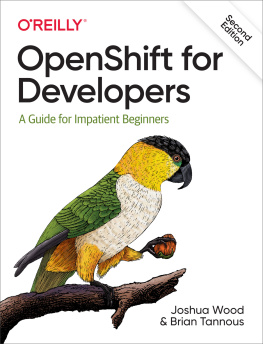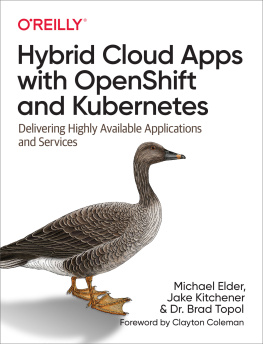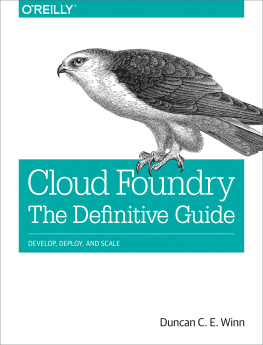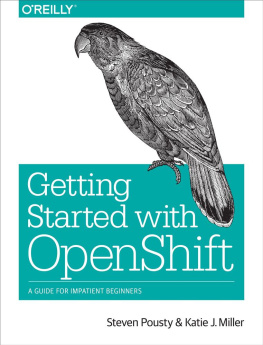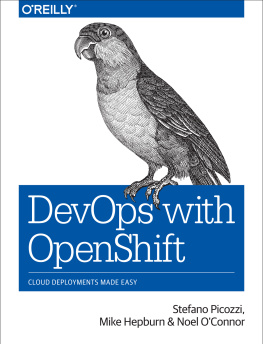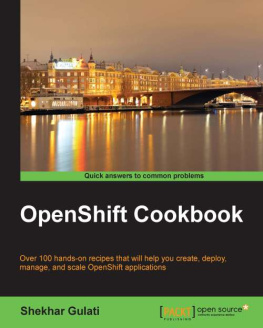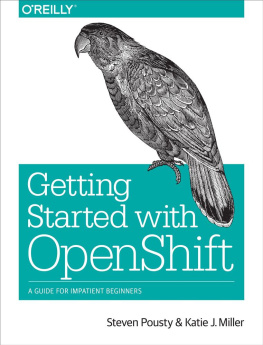Miller - Implementing OpenShift
Here you can read online Miller - Implementing OpenShift full text of the book (entire story) in english for free. Download pdf and epub, get meaning, cover and reviews about this ebook. year: 2013, publisher: Packt Publishing, genre: Computer. Description of the work, (preface) as well as reviews are available. Best literature library LitArk.com created for fans of good reading and offers a wide selection of genres:
Romance novel
Science fiction
Adventure
Detective
Science
History
Home and family
Prose
Art
Politics
Computer
Non-fiction
Religion
Business
Children
Humor
Choose a favorite category and find really read worthwhile books. Enjoy immersion in the world of imagination, feel the emotions of the characters or learn something new for yourself, make an fascinating discovery.
Implementing OpenShift: summary, description and annotation
We offer to read an annotation, description, summary or preface (depends on what the author of the book "Implementing OpenShift" wrote himself). If you haven't found the necessary information about the book — write in the comments, we will try to find it.
The cloud is a liberating environment when you learn to master OpenShift. Follow this practical tutorial to develop and deploy applications in the cloud and use OpenShift for your own Platform-as-a-Service.
Overview
- Discover what the cloud is, tear through the marketing jargon, and go right to the tech
- Understand what makes an open source Platform-as-a-Service work by learning about OpenShift architecture
- Deploy your own OpenShift Platform-as-a-Service cloud using DevOps orchestration and configuration management
In Detail
Gone are the days of having to provision hardware, deploy, and manage an entire environment just to write code for the next big idea, project, or custom web application. A Platform-as-a-Service cloud aims to fulfill this need, allowing developers to work more efficiently as well as allowing DevOps teams to spend less time fulfilling requests for these environments. Join us as we move into the future with OpenShift.
Implementing OpenShift will walk the reader through how to easily develop and deploy upon an open source OpenShift Platform-as-a-Service. We will then discuss the architecture of the platform so that users have some insight into the inner workings of the environment. We will then take a step away from the user aspect and cover DevOps topics so that we can perform the deployment of our very own open source Platform-as-a-Service using the upstream OpenShift Origin code base.
Developers are no longer in need of provisioning full-scale development environments by provisioning servers, installing and configuring software, and maintaining infrastructure just to write software. This book will show you how developers can move out of this archaic mindset and into the future utilizing OpenShift Platform-as-a-Service technologies, breaking away from the marketing jargon and into the technology that allows developers to get work done. This book also delves into the realm of DevOps, allowing you to run your own environment to support your development teams more efficiently.
This book will show you how the OpenShift Platform-as-a-Service can redefine the way web application developers work by providing the building blocks upon which they are able to create their next big idea. From there, the reader will progress through the OpenShift architecture and on to a brisk automated deployment using DevOps technologies.
You will learn everything you need to know in order to use OpenShift to develop and deploy applications in the cloud as well as how to deploy your very own OpenShift Origin-based Platform-as-a-Service cloud.
What you will learn from this book
- Learn more about the cloud, its different service models, and what each one means to their target audiences
- Master the use of OpenShift Online through the command line, web interface, and IDE integrations
- Understand the OpenShift architecture, breaking into how the open source Platform-as-a-Service works internally
- Deploy an OpenShift Origin-based Platform-as-a-Service in your own environment using DevOps automation tools
Approach
A standard tutorial-based approach to using OpenShift and deploying custom or pre-built web applications to the OpenShift Online cloud.
Who this book is written for
This book is for software developers and DevOps alike who are interested in learning how to use the OpenShift Platform-as-a-Service for developing and deploying applications, how the environment works on the back end, and how to deploy their very own open source Platform-as-a-Service based on the upstream OpenShift Origin project.
Miller: author's other books
Who wrote Implementing OpenShift? Find out the surname, the name of the author of the book and a list of all author's works by series.

